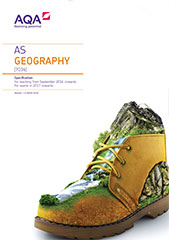3.2 Human geography
Changing places
This section of our specification focuses on people's engagement with places, their experience of them and the qualities they ascribe to them, all of which are of fundamental importance in their lives. Students acknowledge this importance and engage with how places are known and experienced, how their character is appreciated, the factors and processes which impact upon places and how they change and develop over time. Through developing this knowledge, students will gain understanding of the way in which their own lives and those of others are affected by continuity and change in the nature of places which are of fundamental importance in their lives.
Study of the content must be embedded in two contrasting places, one to be local. The local place may be a locality, neighbourhood or small community either urban or rural. A contrasting place is likely to be distant – it could be in the same country or a different country but it must show significant contrast in terms of economic development and/or population density and/or cultural background and/or systems of political and economic organisation.
The place studies complement the requirement to embed the study of content in two contrasting places. Study of this section offers particular opportunities to exercise and develop qualitative (and quantitative) investigative techniques and practice-related observation, measurement and various mapping skills, together with data manipulation and statistical skills including those associated with and arising from fieldwork.
The nature and importance of places
The concept of place and the importance of place in human life and experience.
Insider and outsider perspectives on place.
Categories of place:
- near places and far places
- experienced places and media places.
Factors contributing to the character of places:
- Endogenous: location, topography, physical geography, land use, built environment and infrastructure, demographic and economic characteristics.
- Exogenous: relationships with other places.
Changing places – relationships, connections, meaning and representation
In relation to the local place within which students live or study and then at least one further contrasting place and encompassing local, regional, national, international and global scales:
- the ways in which the following factors: relationships and connections, meaning and representation, affect continuity and change in the nature of places and our understanding of place
and
- the ways in which students’ own lives and those of others are affected by continuity and change in the nature of places and our understanding of place.
Relationships and connections
The impact of relationships and connections on people and place with a particular focus on:
either
changing demographic and cultural characteristics
or
economic change and social inequalities.
- How the demographic, socio-economic and cultural characteristics of places are shaped by shifting flows of people, resources, money and investment, and ideas at all scales from local to global.
- The characteristics and impacts of external forces operating at different scales from local to global, including either government policies or the decisions of multinational corporations or the impacts of international or global institutions.
- How past and present connections, within and beyond localities, shape places and embed them in the regional, national, international and global scales.
Meaning and representation
The importance of the meanings and representations attached to places by people with a particular focus on people's lived experience of place in the past and at present.
- How humans perceive, engage with and form attachments to places and how they present and represent the world to others, including the way in which everyday place meanings are bound up with different identities, perspectives and experiences.
- How external agencies, including government, corporate bodies and community or local groups make attempts to influence or create specific place-meanings and thereby shape the actions and behaviours of individuals, groups, businesses and institutions.
- How places may be represented in a variety of different forms such as advertising copy, tourist agency material, local art exhibitions in diverse media (eg film, photography, art, story, song etc) that often give contrasting images to that presented formally or statistically such as cartography and census data.
- How both past and present processes of development can be seen to influence the social and economic characteristics of places and so be implicit in present meanings.
Quantitative and qualitative skills
Students must engage with quantitative and qualitative approaches across the theme as a whole. Quantitative data, including the use of geospatial data, must be used to investigate and present place characteristics, particular weight must be given to qualitative approaches involved in representing place, and to analysing critically the impacts of different media on place meanings and perceptions. The use of different types of data should allow the development of critical perspectives on the data categories and approaches.
Place studies
Local place study exploring the developing character of a place local to the home or study centre.
Contrasting place study exploring the developing character of a contrasting and distant place.
Place studies must apply the knowledge acquired through engagement with prescribed specification content and thereby further enhance understanding of the way students' own lives and those of others are affected by continuity and change in the nature of places. Sources must include qualitative and quantitative data to represent places in the past and present.
Both place studies must focus equally on:
- people's lived experience of place in the past and present
and either
- changing demographic and cultural characteristics
or
- economic change and social inequalities.
Suitable data sources could include:
- statistics, such as census data
- maps
- geo-located data
- geospatial data, including geographic information systems (GIS) applications
- photographs
- text, from varied media
- audio-visual media
- artistic representations
- oral sources, such as interviews, reminiscences, songs, etc.
